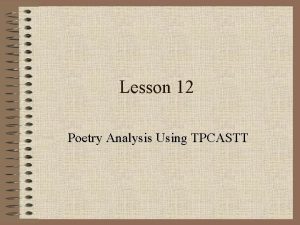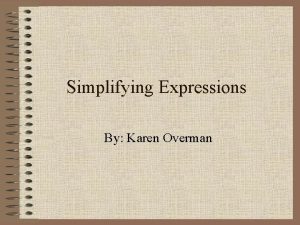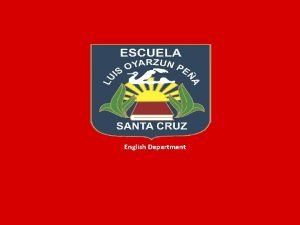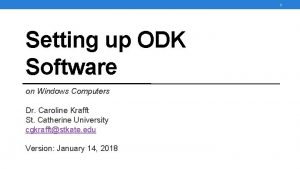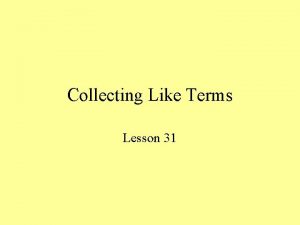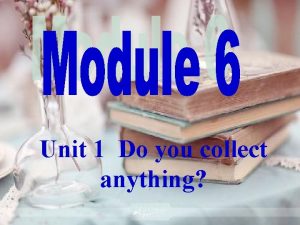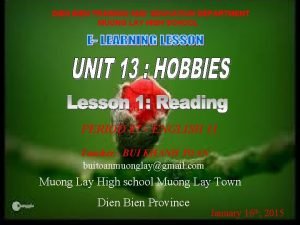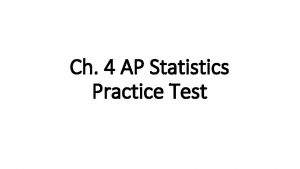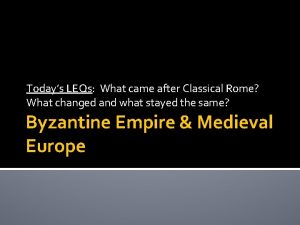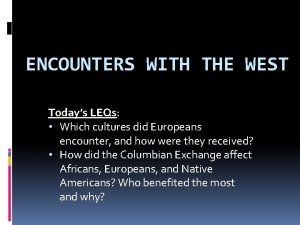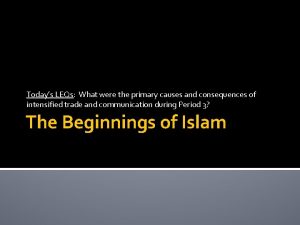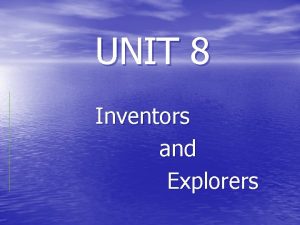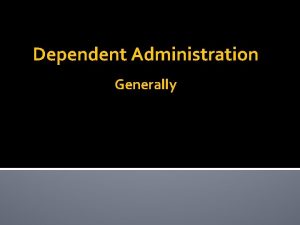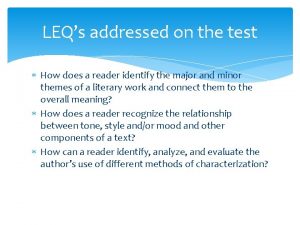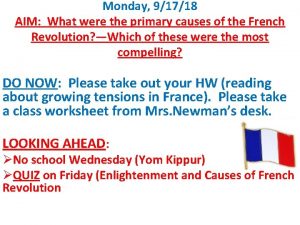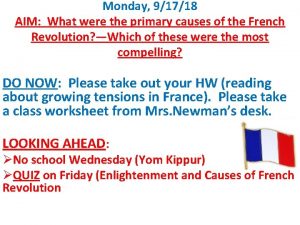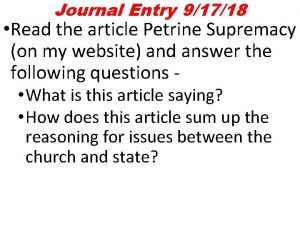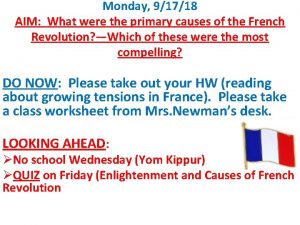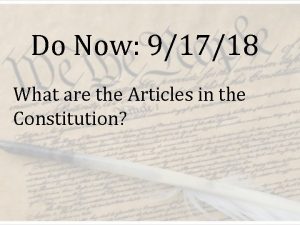Todays Agenda 91718 1 Collect practice LEQs 2




















![“He [Penn] will compel no man to belong to his particular Society of Friends. “He [Penn] will compel no man to belong to his particular Society of Friends.](https://slidetodoc.com/presentation_image_h2/5a944ddea1f676589affa50b95d86ba2/image-21.jpg)





- Slides: 26

Today’s Agenda (9/17/18): 1) Collect practice LEQs 2) Discussion: After the Mayflower (Thurs. HW) 3) Today’s Key Understanding 4) British North America: The 13 Colonies Take Shape

For Tomorrow & Beyond: • Finish up Many Thousands Gone assignment for tomorrow (if not complete over the weekend)

After the Mayflower – Analysis/Reflection Was THIS the “origin story” you were expecting to hear? ? ?

The “Threat” Posed to English Colonists by Indigenous Peoples: • Major – an obstacle in the way of land acquisition • Minor – the “betrayal” potential of indigenous people (consequences of living in such close contact with indigenous, inability to protect colony against all indigenous threats, etc. ) As Prof. Jill Lepore stated, the close contact between the two groups and their habits (particularly the Indian customs, traditions, and actions) would put the incredibly suspicious and superstitious Pilgrims on edge each time contact was made.

Lessons of Contact: The Pequot War If the Pequot War taught any lessons, it was two-fold. On one hand, the English (through their own strength and with help from their allies) COULD destroy a major indigenous power in the region for geopolitical control (in this case, the Connecticut River). On the other hand, it demonstrated to the surrounding indigenous population the brutality of European-based warfare as well as the fact that the English could no longer be considered “weak” or “easily-controlled”.

Lessons: The “Praying Indian Towns” As we saw, Rev. John Elliot established several “praying Indian towns” which were meant to be guaranteed “safe havens” for Indians who conformed to strict Puritan beliefs. All “Praying Indians” were expected to give a full “conversion” in front of an all-white Congregation in order to be “accepted” as a Christian according to Puritan standards. By King Philip’s Rebellion, however, even “praying Indians” in NE were seen as untrustworthy and potentially dangerous (the “fifth column” element) and were expelled or sold into slavery.

Lessons: King Philip’s War (1675 -1678) As we saw in the concluding scenes of After the Mayflower) Metacom/Philip (the heir of Massasoit) was placed in a position of crisis as English expansion into more and more of his and other Algonquian territory (as well as the impact of Praying Towns on the culture and beliefs of his people) took its toll on what was once a land that was shared between English colonist and Indian inhabitant. By the end (and with Philip’s death), the Algonquian people of New England could no longer pose a security threat to the burgeoning English population due to the impact of war, disease, land-loss, and forced/voluntary resettlement on lands further west.

Today’s Key Understanding: • Europeans developed a variety of colonization and migration patterns, influenced by different imperial goals, cultures, and the varied N. American environments where they settled, and the competed with each other and Native Americans for resources • What to Think About: How did the 13 British North American colonies “take their shape” (geographically, politically, socially, etc. ) during this time period?

British N. America: The 13 Colonies Take Shape (1660 -1732)

Three Types of Colonial Set-Up – Important • Joint-Stock • Proprietorship • Royal

REMEMBER!! (Important) • The 13 were simply just a part of an expanding British Empire in the 17 th 18 th centuries (including Ireland, Canada, India, Caribbean) • The 13 mainly began as joint-stock ventures and proprietorships (not as government mandates i. e. New Spain, New France) Even the so-called “lost colony of Roanoke” in the late 1500 s was financed by Sir Walter Raleigh and was meant to be a place where English privateers could launch raids on Spanish ships to enrich themselves and the Crown. Raleigh was a speculator hoping to sell the land to these individuals looking to make a quick score off the Spanish.

REMEMBER!!! (Important) – cont’d • In many cases, N. America was one of the LAST places English immigrants wanted to immigrate to during the 1600 searly 1700 s! Most English immigrants found either Ireland or the West Indies as a much more popular destination than the imposing, difficult, and presumed dangerous shorelines of North America.

REMEMBER!! (Important) – cont’d • Chesapeake (1607) and New England (1620) were NOT instant success stories; it took DECADES before either were viable • Success was predicated on profitability, a dedicated labor force, and the eradication of the Native American “threat” through land-loss and toll of disease/war The results of the English-Powhatan Wars (16221646) in the Chesapeake and the Pequot War/Philip’s Rebellion (1636 -1638, 1675 -1676) in New England did irreconcilable damage to tribes in the respective regions.

The “Joint-Stock” Approach – Mainly Trivia • Trivia - Private investors pooled money together to finance voyages/hire workers • Trivia - Profits from sale of exports would repay and enrich investors • Trivia - Political leadership was in hands of “company agents” sent from London under orders from Company board (not directly from the Crown) • Important: ALL J-S colonies had to be approved of/granted land by a royal charter The seal of the Virginia Company of London (founded 1606 -dissolved 1624). VACL (which received its Charter from King James I) had the exclusive right to “colonize” land in and around the Chesapeake region of N. America as a private venture. This meant that the VACL was responsible for EVERYTHING pertinent to the colony’s success (including security).

Map - Charters for Joint Stock Colonization King James I’s charters to the London Company included land south of the 38 th parallel (present day VA and N. Carolina). He also granted the Puritan-based Plymouth Company land north of the 41 st which opened the door to the mass-migration of Puritans to North America in the years prior to the English Civil War. The land in yellow (PA, DE, NY) had already been claimed by the Swedish and Dutch.

Roots of Autonomous Rule Often times, charters did not specifically say where they had to be headquartered. Several colonial enterprises took advantage of this loophole to make their own decisions OUTSIDE the lines of the Company’s charter/investors (such as the Puritan-based Massachusetts Bay Company which moved their headquarters to Boston in 1630—away from London’s grasp). Other colonies bought out their investors and obtained both financial and political independence in the process—though they still politically considered themselves subjects of England.

Autonomous Rule (cont’d) In the case of the Colony of Rhode Island (founded by Puritan dissidents in 1643), it simply created itself as an independent commonwealth with its own legislative powers until it was recognized by a royal charter in 1663. The Colony of Connecticut did the exact same thing under similar circumstances.

1622 -1646: Impact of the English. Powhatan In Virginia, it was a different story. After almost 15 years of bickering, encroachment, and violence between Powhatan’s Algonquin Confederacy and the poorly-led Jamestown settlers of the VACL, Powhatan’s warriors launched a major offensive that attempted to “drive the English back into the sea” beginning in 1622. The fighting would last sporadically for the next 24 years but before it ended, the Crown revoked the VACL charter and officially took over the affairs of the colony (lasting until the Revolution)

Proprietorships - Important • Land grants from the monarch to individuals or groups (including PA, MD, Carolinas) • Often as payment for debts or reward for loyal service • Most “proprietors” never stepped foot in their own colony (benefiting off sale of land to speculators in London) William Penn (unlike most of his other proprietor peers) actually visited and planned out the set-up of his colony. England, however, remained his permanent residence.

Penn’s “Holy Experiment” William Penn’s colony of Pennsylvania was unique to the British colonial experience. Founded in 1681, Penn envisioned his colony as a “holy experiment” in religious/social tolerance that did not exist in British North America at the time. Unlike Puritan-dominated New England the Anglican-dominated South, Penn established no official “church” for his colony, welcoming all Christian faiths (non-Christian immigrants were still excluded). In response, Pennsylvania became one of the most cosmopolitan colonies as thousands from all over Western Europe immigrated into its farmlands and woodlands. Penn also codified fair land deals with Lenape tribes and demanded that his colonists treat all Native peoples respectfully and maintain peace. He doubled-down on this by establishing no formal militia for PA.
![He Penn will compel no man to belong to his particular Society of Friends “He [Penn] will compel no man to belong to his particular Society of Friends.](https://slidetodoc.com/presentation_image_h2/5a944ddea1f676589affa50b95d86ba2/image-21.jpg)
“He [Penn] will compel no man to belong to his particular Society of Friends. ” – Francis D. Pastorius, German Immigrant to PA and founder of Germantown As Pastorius puts succinctly in his “Notes on Germantown”, William Penn was not looking to impose his version of Christianity [Quakerism] on any resident of his colony. PA became a pluralistic haven of different Christian denominations such as Methodists, Lutherans, Quakers, Mennonites as well as varying Native American religious beliefs.

Cecil Calvert (Lord of Baltimore 1605 -1675) was another proprietor who was granted land above the VA company’s borders which became the proprietorship of Maryland in 1632. Calvert (a Catholic) appointed family members to rule directly in the colony which stayed in the Calvert name until the eve of the Revolution. By that point, however, the Calverts ruled in name only, as a legislative assembly made up by the overwhelming Protestant majority living in the colony controlled its political system.

Proprietary/Royal Colony of the Carolinas N. & S. Carolina (founded originally as one colony in 1663) was granted to 8 lord proprietors who divided and sold land to speculators as they pleased (mostly absentee landlords back in England or West Indies). South Carolina in particular drew interest from landowners in Barbados looking to recreate the W. Indies style of plantation life on the mainland. By 1729, however, BOTH Carolinas had surrendered their proprietary status and had become Crown colonies (seeking more direct political representation/protection)

Advent/Establishment of Royal Colonies - Important • RC = ruled by appointed administrators of Crown • Principles 1) King = final authority on col. matters (usually not directly active) 2) King = broker of all unsold public lands (payable to treasury) 3) Governor = appointed admin (bureaucrat; answers to Crown, administers land deals, etc. ) 4) Popularly-elected assemblies for purpose of legislature As we will see, on the eve of the Revolution, 8 of the 13 colonies would be Royal (either by origin, proclamation, or choice).

Politics of the 13 - Important • VERY contingent on local population and their vision, desires, beliefs • New England = EXTREMELY autonomous attitude (Separatist/Puritan beliefs), SOMEWHAT more egalitarian in power distribution • Lower South = stronger Anglican ties, stronger Crown loyalty, more power held by emerging planter elites than commoners • One commonality: By 1763, ALL 13 felt they had a right as “freeborn Englishmen” to make autonomous political decisions As we will see, prior to the Glorious Revolution of 1688 -1689, attempts were made by the Stuart kings to curtail local power in the 13 N. American colonies

Closure: • What are some key differences we see between J-S, Proprietorships, and Royal Chartered colonies in British N. America?
 Leq paragraph structure
Leq paragraph structure Todays agenda
Todays agenda Agenda sistemica y agenda institucional
Agenda sistemica y agenda institucional To see in the past
To see in the past Statistics is the science of conducting studies to
Statistics is the science of conducting studies to Collect and organize data
Collect and organize data How to collect like terms
How to collect like terms Collect past tense
Collect past tense Srx idp configuration
Srx idp configuration Ami els-collect
Ami els-collect Odk collect for pc
Odk collect for pc Understanding data and ways to systematically collect data
Understanding data and ways to systematically collect data Instruments in quantitative research
Instruments in quantitative research Collect rubbish selectively
Collect rubbish selectively Terms with the same literal coefficients
Terms with the same literal coefficients Word collect
Word collect Show can collect air
Show can collect air Charge collect
Charge collect Do you collect anything
Do you collect anything Swept
Swept Syndicated data analysis
Syndicated data analysis Fear 2. hali
Fear 2. hali I just collect stamps from discarded envelopes
I just collect stamps from discarded envelopes Collect hw
Collect hw Simplest form algebra
Simplest form algebra Talk collect
Talk collect Chapter 4 ap statistics practice test
Chapter 4 ap statistics practice test

